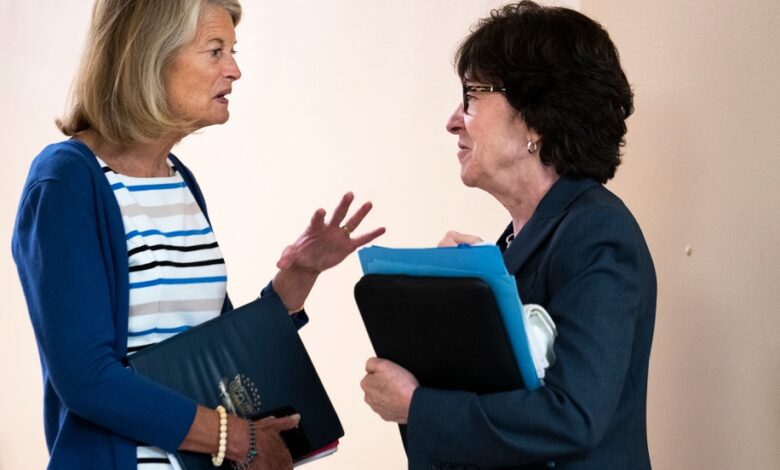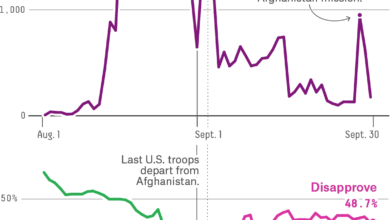Which Republicans Could Vote For A Debt Ceiling Increase?

Which Republicans Could Vote For A Debt Ceiling Increase?
A look at the GOP Senate and House caucuses ahead of 2023’s key legislative fight.
Sens. Lisa Murkowski and Susan Collins — long-tenured moderates — are among the Senate Republicans most likely to support legislation that increases the debt ceiling.
Nothing is certain in this life, but the United States will definitely need to raise its debt ceiling later this year to avoid a potentially calamitous debt default. On one side, President Biden and Democrats want a “clean” debt limit increase, while Republicans want future decreases in spending included in any deal.
To avoid a default, the Republican-controlled House and the Democratic-controlled Senate and White House will have to reach a compromise. This is neither new nor unprecedented. There have been 20 votes on increases to or suspensions of the debt ceiling since 2001, 12 occurring under a divided government. In each case, a deal was reached.
Some in the GOP have made it clear that they won’t vote to raise the borrowing limit this time, even if they can enact all the cuts they desire. And not one Republican sitting in the current Congress backed a debt ceiling hike in the last Congress — although a few GOP senators voted to bypass a filibuster.1 However, about 3 in 5 Republicans currently in Congress have at some point voted for a deal that included a debt ceiling increase. So even though Republicans have been less likely than Democrats to back legislation that included raising or suspending the debt ceiling, some are still willing to do so.
Who are these Republican senators and representatives? In what facets of the party can a compromise be reached? We dug into the voting history and ideological makeup of congressional Republicans to find out.
House Republicans
Here at the start, House Republicans appear united in their opposition to a clean debt ceiling hike, whether we’re talking about the most right-wing or more centrist members. We looked at the final roll call votes on the 20 bills that included a debt ceiling increase since the start of George W. Bush’s presidency and calculated how often current members of the House supported them. Unsurprisingly, the more conservative a member’s voting record, the less likely they’ve been to vote yes on a debt limit hike, as the chart below shows. (Although we must remember that some legislation simply raised the ceiling while other bills contained many additional components.)
Still, this finding isn’t necessarily a shock considering the GOP’s traditional commitment — at least rhetorically — toward reduced spending and less government. But when thinking about who might sign onto a deal, the members closer to the top left corner of that chart may be most inclined to support increasing the borrowing limit. Some well-known moderates, like Pennsylvania Rep. Brian Fitzpatrick and California Rep. David Valadao, fall in this zone. There are also a number of long-tenured members with less conservative records and a past tendency to back debt ceiling hikes, including the two most senior members of the House GOP: Kentucky Rep. Hal Rogers and New Jersey Rep. Christopher Smith, who were both first elected in 1980.
But some representatives who aren’t necessarily described as “moderate” also have moderately conservative voting records and have shown a willingness to vote for debt ceiling increases. One high-profile example is Rep. Elise Stefanik of New York, a Trump ally who has voted for debt limit hikes four times in six opportunities. Now, Stefanik voted for all three increases during Trump’s time in office and, like all other current Republican members, didn’t back either deal during Biden’s tenure so far. Yet in her first term, Stefanik did back GOP Speaker John Boehner’s final debt ceiling agreement with President Barack Obama.
Many of the Republicans whose voting records suggest they are most amenable to raising the debt limit belong to the Main Street Caucus, a group of nearly 70 legislators that describes itself as the home of “pragmatic” conservatives. Out of the 46 members who have taken a vote on the debt ceiling, 10 have backed a hike at least half the time, including Fitzpatrick, Stefanik and Valadao. And while we don’t have any voting records for those elected last November, 18 other members of the MSC are freshmen who could be open to voting for a debt ceiling deal: Roughly one-third of them hail from potentially competitive House seats, and we know that, broadly speaking, members from competitive seats tend to have more centrist voting records.
Meanwhile, on the other end of the spectrum, members of the very conservative Freedom Caucus are unlikely to back a debt ceiling agreement unless it involves deep spending cuts — an arrangement that Biden and Democrats probably won’t accept. We don’t have a public list of the group, which keeps its official membership hush-hush, but it has 40 to 50 members. Most of the ones we could readily identify have never voted for a debt-ceiling increase, although around two-fifths of its members have only been in office since 2021, a period when no Republican voted for an increase.
Senate Republicans
Senate Minority Leader Mitch McConnell and his GOP Senate colleagues have mostly let McCarthy take the early lead on debt ceiling negotiations. But that doesn’t mean the Senate won’t be an important arena in this process — or a potential obstacle to a deal. Here, too, one party has a narrow majority, as Democrats only hold 51 seats to the Republicans’ 49.2 That slim edge makes for close votes on legislation, but also means that Democrats are well short of the 60-vote supermajority needed to invoke cloture to move legislation to the Senate floor for an up-or-down vote. That means both past Senate votes on debt ceiling legislation and past votes on cloture are of interest for us.
We found that support for legislation that includes a debt limit hike was even more clearly related to ideology, based on roll-call votes. The average senator has been in Congress a longer time than the average representative — including time as a representative before moving up to the Senate. Additionally, while the Senate’s consensus-oriented tradition has ebbed in modern times, we still tend to see debt ceiling legislation passed with larger majorities there than in the House. As a result, the current batch of Senate Republicans has, on average, voted yes more often than their House counterparts.
When it comes to which GOP senators are most likely to be involved in passing a debt limit increase, we unsurprisingly start with the chamber’s two prominent moderates: Sens. Susan Collins of Maine and Lisa Murkowski of Alaska. Collins has voted for three-fourths of debt ceiling bills since 2001, while Murkowski has voted for nearly 7 in 10. But in looking for other potential votes, some other names may surprise. Sens. Kevin Cramer of North Dakota and Mike Rounds of South Dakota have supported two of every three debt ceiling bills that have come before them. And indicative of his common involvement in dealmaking on the debt ceiling, McConnell has supported 65 percent of the bills that have come before the Senate since 2001.
But as the use of the cloture motions has increased in recent years, arguably the more important part of the equation in the Senate is overcoming a filibuster to bring debt ceiling legislation to the floor. If nine Republicans don’t agree to go along with 51 Democrats on a cloture vote, a bill won’t receive an up-or-down vote on passage. Take what happened in October 2021, when Democrats had 50 senators3 and a majority through Vice President Harris’s tie-breaking vote. Democrats and Republicans agreed to a short-term debt limit increase, and 11 Republicans voted with the entire Democratic caucus to clear the 60-vote hurdle to move the bill to the floor, where it passed 50-48 on a party-line vote with two GOP absences. But three of the 11 Republicans who helped make that happen retired ahead of the 2022 election, leaving just eight GOP senators in the chamber who voted for cloture back then.
Many Republicans have voted for cloture — but not recently
Cloture votes to overcome filibusters against debt ceiling legislation by Republican senators currently in Congress, based on votes from 2001 to 2021
Senator
State
Has voted in Senate
Has ever voted yes for cloture
Voted yes for cloture in Oct. 2021
Susan Collins
ME
✓
✓
✓
Mitch McConnell
KY
✓
✓
✓
Lisa Murkowski
AK
✓
✓
✓
John Barrasso
WY
✓
✓
✓
John Cornyn
TX
✓
✓
✓
John Thune
SD
✓
✓
✓
Shelley Moore Capito
WV
✓
✓
✓
Mike Rounds
SD
✓
✓
✓
Roger Wicker
MS
✓
✓
Lindsey Graham
SC
✓
✓
John Boozman
AR
✓
✓
John Hoeven
ND
✓
✓
Bill Cassidy
LA
✓
✓
Mike Crapo
ID
✓
✓
Chuck Grassley
IA
✓
✓
Jerry Moran
KS
✓
✓
Tim Scott
SC
✓
✓
Thom Tillis
NC
✓
✓
Todd Young
IN
✓
✓
Tom Cotton
AR
✓
✓
Ted Cruz
TX
✓
✓
Deb Fischer
NE
✓
✓
Dan Sullivan
AK
✓
✓
Kevin Cramer
ND
✓
✓
Joni Ernst
IA
✓
✓
Cindy Hyde-Smith
MS
✓
✓
John Kennedy
LA
✓
✓
Marco Rubio
FL
✓
✓
Marsha Blackburn
TN
✓
Mike Braun
IN
✓
Steve Daines
MT
✓
Bill Hagerty
TN
✓
Josh Hawley
MO
✓
Ron Johnson
WI
✓
James Lankford
OK
✓
Mike Lee
UT
✓
Cynthia Lummis
WY
✓
Roger Marshall
KS
✓
Rand Paul
KY
✓
Jim Risch
ID
✓
Mitt Romney
UT
✓
Rick Scott
FL
✓
Tommy Tuberville
AL
✓
Katie Britt
AL
Ted Budd
NC
Markwayne Mullin
OK
Pete Ricketts
NE
Eric Schmitt
MO
J.D. Vance
OH
In Senate cloture votes, 60 votes of support are needed to overcome a filibuster.
Source: Congressional Research Service, U.S. Senate, VoteView.com
Here, too, many of the usual, more moderate suspects, like Collins, Murkowski and Sen. Shelley Moore Capito of West Virginia, have voted for every cloture motion involving the debt ceiling that’s been before them in the 21st century. Party leadership has also been willing to do so: McConnell voted for every cloture motion in that time, while South Dakota Sen. John Thune (party whip) and Wyoming Sen. John Barrasso (conference chairman) voted for cloture in six of seven cases. If there’s a cloture vote this year, it’s unclear who else might join the eight who backed it in October 2021. If electoral considerations come into play — and when don’t they? — it could be someone like Texas Sen. John Cornyn, who isn’t up again until 2026 and has also voted for cloture six of seven times. At the same time, Barrasso is up in 2024, so he may have reason to be hesitant to help advance legislation this time around.
But maybe it won’t come to that. Back in December 2021, the Senate passed a one-time carveout to the filibuster that allowed an up-or-down vote on the debt ceiling. That demonstrated a flexibility with the rules that could come in handy if the clock is ticking down to debt default. Granted, to get that carveout the Senate had to successfully invoke cloture on the legislation enabling it. But most of the same group of senators who voted for cloture on the October 2021 deal also voted for it on that bill, as did Iowa Sen. Joni Ernst (the GOP’s policy committee chair), North Carolina Sen. Thom Tillis, Mississippi Sen. Roger Wicker and Utah Sen. Mitt Romney, whose otherwise moderate voting record hasn’t included any support for any debt ceiling legislation.
We’re far from knowing just what a debt ceiling deal will look like. And the actual components of the bill, the give and take by both sides, will help determine how amendable Republicans are to voting for the legislation. But looking back at previous votes on the debt ceiling, we have some idea of who is most likely to support raising the nation’s borrowing limit.





